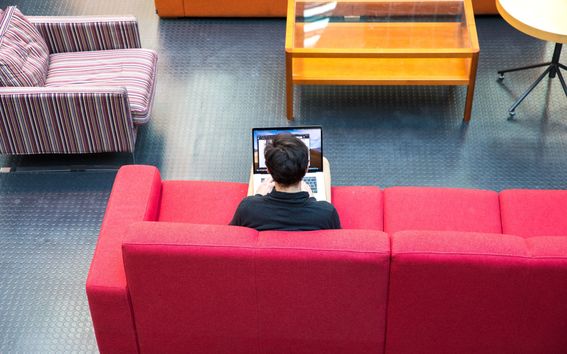Lessons learnt from the transition to remote studies will be used in the future

Lectures, calculation exercises and project work were transferred to online platforms and video meetings in record time as Aalto University moved fully to long-distance studies in mid-March due to the coronavirus epidemic.
This spring has required flexibility from both teaching staff and students. In addition to digital tools, self-management skills have become increasingly important, says Vice Dean Keijo Nikoskinen, who is responsible for teaching at the School of Electrical Engineering.
‘Transitioning to long-distance studies has been like a leap into cold water. However, teachers have taken a constructive approach to the situation and developed new operating methods rapidly’, says Nikoskinen.
According to a survey conducted by the Learning Services of the School of Electrical Engineering, which was closed in May, 70 per cent of the students at the school agreed or somewhat agreed that they had been able to conduct their studies well and to progress in their studies during long-distance studies. A quarter of the students disagreed or somewhat disagreed.
Lectures work well over video, but interaction is harder to achieve
According to University Lecturer Anu Lehtovuori, the transition to long-distance studies was surprisingly smooth. In the spring, Lehtovuori taught a course with over one hundred bachelor’s degree students and a smaller-scale course for master's and postgraduate students.
On the mass course, lectures were done as recorded video bulletins, supplemented with online materials. With the smaller course, Lehtovuori held the lectures live on Zoom. Feedback received from the students was mainly positive.
‘Digital tools have already been used on many courses, so many people were familiar with them to begin with’, says Lehtovuori.
Matti Kuosmanen, a student in the Electronics and Nanotechnology master's programme, says that lectures and calculation exercises have worked remotely as well. Guidance sessions and help have been available.
‘The best thing has been that teaching has not been tied to time or place as strongly’, says Kuosmanen, but adds: ‘However, asking questions and active participation is more difficult than in contact teaching. Working together with other students has been very useful in the courses, but now it has surely decreased for many.’
Lehtovuori and her colleagues have also noticed that it is difficult to create interaction on remote courses. In the survey, about 45 per cent of the students agreed or somewhat agreed that a sense of community has been maintained remotely as well.
‘In online forums, you don't get the silent team spirit and opportunities to reflect with the person next to you that you have in a genuine interactive situation. We need to think about solutions for increasing interaction in the future’, says Lehtovuori and adds: ‘Long-distance studies are certainly not suitable for everyone, especially if the situation is prolonged. The importance of real-life peer support is great.’
Effects are most evident on practical courses
The School of Electrical Engineering has not had to cancel any courses due to the situation. In the summer, there are actually slightly more courses available than usual. However, long-distance studies have caused major changes in performance methods, especially on practical courses.
Melina Sundell, a first-year electrical engineering student, took part in an electrical workshop course during the spring semester where student groups plan and implement various electronics building projects. Without the tools at the workshop, the construction of the robot submarine Sundell's group was planning mainly resulted in theoretical work.
‘Our project would have required programming, but the programming language used was not familiar to any one of us. You have to make compromises on the final result when low-threshold help is not available and you can't go get components from the workshop’, Sundell says.
In Matti Kuosmanen's studies, laboratory work has been replaced by assignments such as writing essays or by additional lectures.
‘Having to cancel laboratory work is a pity, because it provides practical experience with measuring equipment, for example’, Kuosmanen says.
Making the best of the exceptional situation
With no real alternative available, this spring has taught everyone useful lessons on the development of long-distance studies. The transition to digital and long-distance studies is a trend that is only growing with the requirements of lifelong learning.
‘In the future, we will have to take the requirements of long-distance studies better into account for both teachers and students. This means the introduction of better digital tools, but also learning important working life skills, such as managing your own schedule and working methods’, says Nikoskinen.
‘In this situation, we have had to quickly change courses in the curriculum into long-distance studies. If we plan long-distance studies from the start, we can plan methods and pedagogical solutions for carrying out courses accordingly’, Anu Lehtovuori points out.
It is also important to guarantee adequate support. According to the survey, about 60 per cent of the students felt that they had received sufficient guidance for their long-distance studies. A quarter felt that there had not been enough support.
‘Guiding small group work has been found more difficult compared to a classroom, as teachers cannot go around and see who needs help. We need to make teachers' cooperation on courses more efficient’, says Nikoskinen.
According to Anu Lehtovuori, IT services for teaching have been a great help in organising long-distance studies. The teachers' weekly virtual coffee breaks have provided important peer support.
‘Members of teaching staff have exchanged tips and supported each other’, says Lehtovuori.
Student survey was sent to 1 744 students of the School of Electrical Engineering, of whom 337 responded. The response rate was 19,3. Survey was open between 5 May and 18 May 2020.
- Published:
- Updated:
Read more news

Online AI course could boost study equality
Students at the School of Business believe that mastering Artificial Intelligence (AI) can be beneficial for both academic success and career prospects, as AI becomes increasingly integrated into daily life.
2 027 new students admitted to Aalto University’s Finnish, Swedish bachelor’s programmes
13 500 applied to Aalto University in Finland's spring joint application in 2024
Meet the the Program Assistants that elevate the Aalto University Summer School experience for 250 students from all over the world
Each year, the Aalto University Summer School has grown its operations and course curriculum tremendously.